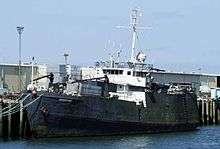USCGC Woodbine (WLB-289)
.png) Woodbine alongside the burned out hulk of USS LST-480 on 22 May 1944, the day after the West Loch Disaster | |
| History | |
|---|---|
| Name: | USCGC Woodbine (WLB-289) |
| Namesake: | Woodbine (plant) |
| Builder: | Zenith Dredge Company, Duluth, Minnesota |
| Cost: | $1,156,000 |
| Laid down: | 2 February 1942 |
| Launched: | 3 July 1942 |
| Commissioned: | 17 November 1942 |
| Decommissioned: | 15 February 1972 |
| Reclassified: | WLB-289, 1965 |
| Fate: | Donated to Cleveland Public School System, 19 June 1972 |
| General characteristics [1] | |
| Type: | USCG seagoing buoy tender |
| Displacement: | 1,025 long tons (1,041 t) (1966) |
| Length: | 180 ft (55 m) |
| Beam: | 37 ft (11 m) |
| Draft: | 13 ft (4.0 m) (1966) |
| Installed power: |
|
| Propulsion: |
|
| Speed: | 12 knots (22 km/h; 14 mph) |
| Range: | 11,000 nmi (20,000 km; 13,000 mi) at 10 knots (19 km/h; 12 mph) (1942) |
| Complement: | 53 (1966) |
| Armament: | Small arms only |
| Notes: | 20-ton boom with electric hoist |
USCGC Woodbine (WAGL-289/WLB-289) was a United States Coast Guard buoy tender.
The ship, a 180 feet (55 m) Cactus- or A-class tender, was built in Duluth, Minnesota by the Zenith Dredge Company, laid down on 2 February 1942, launched on 3 July 1942, and commissioned on 17 November 1942, as Woodbine (WAGL-289).[1]
Service history
Atlantic coast, 1942–1944
Woodbine was assigned to Norfolk, Virginia for general aids-to-navigation (ATON) duties, but did not arrive at her post until 5 February 1943, being delayed by several unscheduled ice-breaking operations.[1]
On 20 September 1943, she was transferred to San Juan, Puerto Rico for aids-to-navigation and law enforcement duties, inspecting vessels suspected of drug trafficking.[1]
World War II, 1944–1945
On 15 January 1944, she sailed from Puerto Rico to Portsmouth Navy Yard for refitting, then sailed to San Francisco, where she was stationed from 7 March 1944. Woodbine was then deployed to the Pacific Theater of Operations to take part in the amphibious assault on the Marianas Islands, and served as a mobile service base for the U.S. Navy's Southern Attack force during the attack on Guam, before taking part in the Okinawa campaign in 1945.[1]
Lake Michigan, 1947–1972
At the end of the war Woodbine returned to the United States, and from 19 September 1947, was stationed in Grand Haven, Michigan, where she remained for the rest of her career.[1]
On 19 April 1965 she was slightly damaged in a collision with MV Meteor while ice-breaking off Green Bay, Wisconsin.[1] I was a seaman aboard the Woodbine when we had the collision.It was a Sunday afternoon around 3:00p.
From 18 to 20 August 1965, she was involved in recovering debris from United Airlines Flight 389 which had crashed into Lake Michigan. Also in 1965 her designation was changed from WAGL (which was a US Navy designation denoting an auxiliary vessel, lighthouse tender) to WLB.[1]
On 6 January 1971, she was deployed to search for the crew of an Air Force B-52 bomber that crashed in upper Lake Michigan, near Charlevoix. Unfortunately, there were no survivors.[2]

1972–
On 15 February 1972, as part of a government-wide savings plan, Woodbine was decommissioned and donated to the Cleveland Public School System through the Department of Health, Education, and Welfare/CSA to be used as a training ship in marine engineering and electronics. In the early 1980s, she was sold to a private owner at the cost of $150,000.[1]
Sometime Prior to 1992 Woodbine was modified and used as a mobile fish-processing vessel in Alaska for the Woodbine Alaska Fishing Company (WAFCO). The buoy deck was enclosed and used as a processing floor with 4 large freezers. On the stern a galley was built and the whole deck aft of the wheelhouse was inclosed to shelter the cardboard used to pack frozen fish in. The forward deck was outfitted with multiple holding tanks for fish waiting to be processed. Towards her end as a processor another shelter was added to the buoy deck. To off set for all the building upwards 30,000 lbs of cement had to be poured in to the lower hold. The design of the processing operation was very simple and had none of the labor saving equipment the other companies used. It was a very labor-intensive at times. unloading the holds of frozen fish had to be done by hand. we ran an all male crew because of close quarters and hard labor conditions. I last stood on her decks in 1995. I quite the company and the M/V Woodbine left of another season. 8 years ago I found the M/V Woodbine tied to the docks in Astoria,Oregon. Her home port had always Been Rio Vista California so I asked around what the story was.I was told "1996 the crew was taking her home for the off season and the company did not make payroll and checks were no good. They decided to not complete the trip and pulled in to Astoria",where the M/V Woodbine would sit for her remaining years until she was sold for scrap around 2012.
References
- 1 2 3 4 5 6 7 8 9 Ashmore, Melissa M. "Woodbine, 1942" (pdf). United States Coast Guard. Retrieved 2009-11-04.
- ↑ Hubbard, Brandon. "38 years ago, B-52 crash claimed nine lives near former Big Rock Point". Petoskey News-Review. Retrieved 2009-11-04.